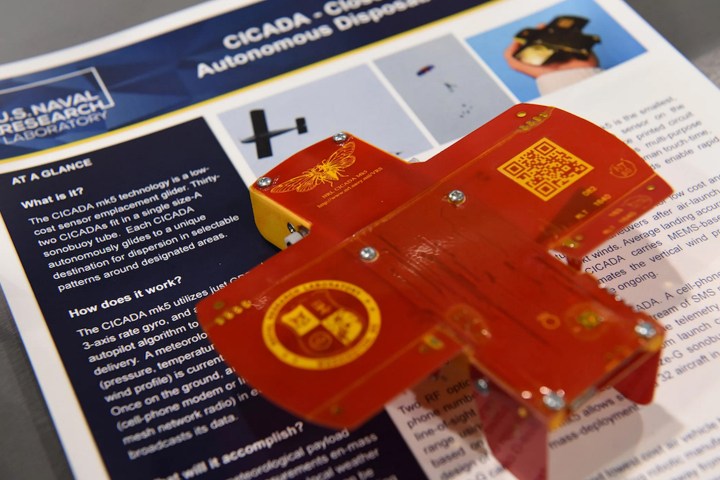
The Close-in Covert Autonomous Disposable Aircraft MK5, or CICADAs, are an inexpensive, autonomous, fleet of GPS-controlled drones. Unlike traditional aerial drones, the CICADAs have no motor or onboard propulsion system. Instead, the 1.2-ounce drones are released midair from an aircraft and then glide to their intended destination. Each CICADA has a “glide ratio” of about 3.5 to 1 — meaning the drone has the ability to glide forward 3.5 feet for every one foot it descends.
The latest CICADA prototype has flat wings and an overall flat build, enabling the “micro aircraft” to be easily stacked in canisters and deployed in large numbers. The Navy is currently using a delivery system that stacks 32 CICADAs into a single cylindrical container for deployment.
Once released from the aircraft, the drones glide to their “intended waypoint, enters an orbit, and then descends within that orbit until it reaches the ground,” according to Dr. Daniel J. Edwards, an aerospace engineer with NRL. The onboard GPS technology allows the CICADAs to navigate and land within roughly 15 feet of their intended target.
The NRL describes the CICADAs as “essentially a flying circuit board” and once deployed in the air, the drones will record chemical, biological, and meteorological information. The Navy hopes this data could be used to better understand the behavior of both hurricanes and tornadoes.
In the future, these research drones could be deployed from a host of aerial vehicles including traditional airplanes, balloons, precision guided munitions, and even other unmanned aircraft or drones. The Navy recently ran the drones through a series of tests in various locations and altitudes ranging up to 8,000 feet. You can watch the Institute of Electrical and Electronics Engineers Spectrum’s full video coverage of the event on YouTube.
Editors' Recommendations
- Wing drone delivery heads to first U.S. metro area
- Autonomous drones are helping to keep a U.S. Air Force base in California secure
- U.K.’s busiest airport deploys new anti-drone system for safer skies
- U.S. Interior Department grounds 800-strong drone fleet over security fears
- U.S. Army takes its pocket-sized reconnaissance drone to Afghanistan


